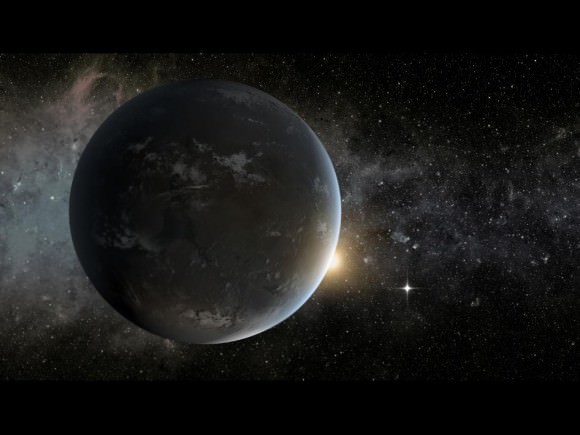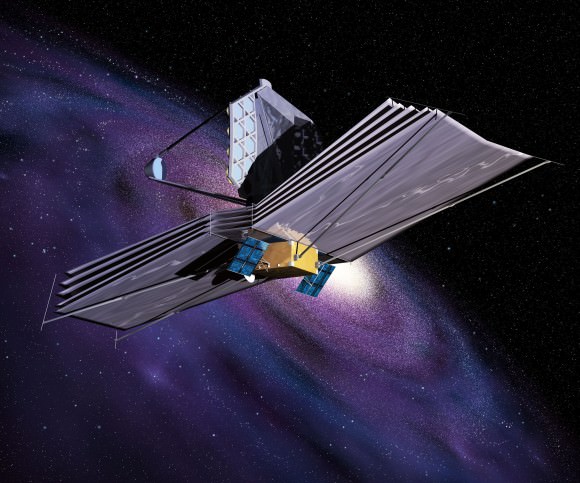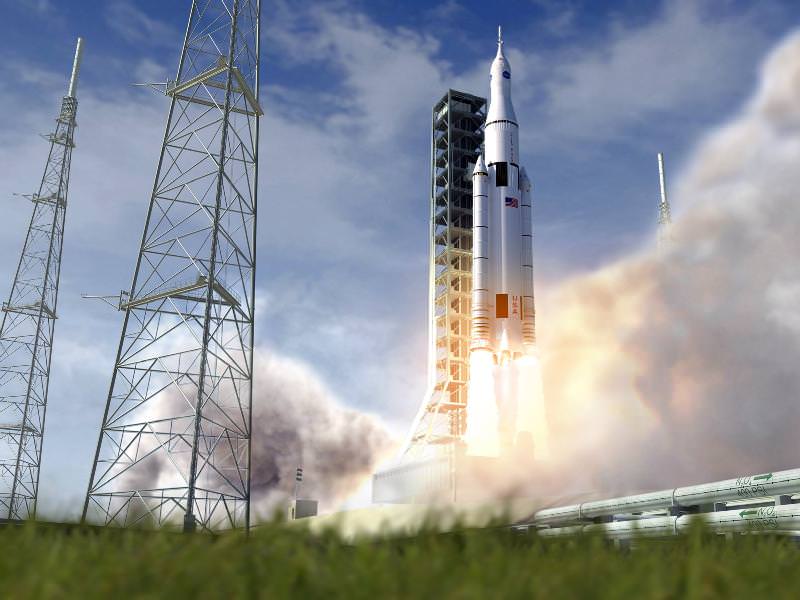In three years, NASA is planning to light the fuse on a huge rocket designed to bring humans further out into the solar system.
We usually talk about SLS here in the context of the astronauts it will carry inside the Orion spacecraft, which will have its own test flight later in 2014. But today, NASA advertised a possible other use for the rocket: trying to find life beyond Earth.
At a symposium in Washington on the search for life, NASA associate administrator John Grunsfeld said SLS could serve two major functions: launching bigger telescopes, and sending a mission on an express route to Jupiter’s moon Europa.
The James Webb Space Telescope, with a mirror of 6.5 meters (21 feet), will in part search for exoplanets after its launch in 2018. Next-generation telescopes of 10 to 20 meters (33 to 66 feet) could pick out more, if SLS could bring them up into space.
“This will be a multi-generational search,” said Sara Seager, a planetary scientist and physicist at the Massachusetts Institute of Technology. She added that the big challenge is trying to distinguish a planet like Earth from the light of its parent star; the difference between the two is a magnitude of 10 billion. “Our Earth is actually extremely hard to find,” she said.

While the symposium was not talking much about life in the solar system, Europa is considered one of the top candidates due to the presence of a possible subsurface ocean beneath its ice. NASA is now seeking ideas for a mission to this moon, following news that water plumes were spotted spewing from the moon’s icy south pole. A mission to Europa would take seven years with the technology currently in NASA’s hands, but the SLS would be powerful enough to speed up the trip to only three years, Grunsfeld said.
And that’s not all that SLS could do. If it does bring astronauts deeper in space as NASA hopes it will, this opens up a range of destinations for them to go to. Usually NASA talks about this in terms of its human asteroid mission, an idea it has been working on and pitching for the past year to a skeptical, budget-conscious Congress.
But in passing, John Mather (NASA’s senior project scientist for Webb) said it’s possible astronauts could be sent to maintain the telescope. Webb is supposed to be parked in a Lagrange point (gravitationally stable location) in the exact opposite direction of the sun, almost a million miles away. It’s a big contrast to the Hubble Space Telescope, which was conveniently parked in low Earth orbit for astronauts to fix every so often with the space shuttle.

While NASA works on the funding and design for larger telescope mirrors, Webb is one of the two new space telescopes it is focusing on in the search for life. Webb’s infrared eyes will be able to peer at solar systems being born, once it is launched in 2018. Complementary to that will be the Transiting Exoplanet Survey Satellite, which will fly in 2017 and examine planets that pass in front of their parent stars to find elements in their atmospheres.
The usual cautions apply when talking about this article: NASA is talking about several missions under development, and it is unclear yet what the success of SLS or any of these will be until they are battle-tested in space.
But what this discussion does show is the agency is trying to find many purposes for its next-generation rocket, and working to align it to astrophysics goals as well as its desire to send humans further out in the solar system.


Ah, Europa and space telescopes! That makes a lot more sense than putting humans in space, just for the sake of putting humans in space. Asteroids and Mars can also be studied way more efficiently by non-human visits.
I’d rather find alien life than see another human having a multi-billion $ trip.
So If it can halve time taken to get to Jupiter man on mars would be a definite possibility, excited now
Do not hang your hopes on a launcher that may not be completed, and if it is, within a NASA budget that isn’t going to see any meaningful increases, SLS operational costs will be too great to afford development of large single-launch payloads that require it…
Anyone remember Energia?
Maintaining JSWT is a manned mission with a decent science payoff for once. Expensive though. I wonder if they will now need to add handles, etc to the telescope, pushing it’s launch date out further.
Nit? “…sending a mission on an express route to Jupiter’s route Europa.” Ehh… “… Jupiter’s moon Europa.”?
SLS will be built and work great but will only fly once or twice. The politicians are only interested in the cost of developing it. The more expensive the more pork to their special interests. They don’t care about flying it. And NASA will choose the ten times cheaper Falcon Heavy for their missions. They have said that their Europa mission will cost less than a billion. One SLS launch will cost more than that.
NASA produces science but also lots of scifi. SLS will never fly anything to Jupiter.
It’s funny how as a species we could possibly determine right now if there are nearby alien civilizations – simply by building gigantic space (or terrestrial) telescopes and imaging planets directly. But no, instead we sink trillions of dollars and man hours of effort into building massive amounts of primitive contraptions with which to murder each other’s fighter-squads.
“A mission to Europa would take seven years with the technology currently in NASA’s hands, but the SLS would be powerful enough to speed up the trip to only three years, Grunsfeld said.”
Okay, I’m not getting it. The Atlas V which launched the New Horizons probe, which took less then a year to reach Jupiter, IS part of NASA’s current technology. Yet it would take seven years for a mission to get to Jupiter’s moon Europa if they used a rocket that has already made it in under a year. Never mind we already have a mission enroute to Europa. Plus NASA does have two current propulsion technologies that can more then double the speed of our chemical rockets. The solar sail, and VASMIR. I must be missing something. Perhaps Ms. Howell meant to say that it would take seven years to get a current technology mission to Europa through Congressional approval, but a mission using the already paid for SLS will only take three years to get through Congress.
New Horizons is fast because it is a flyby. It takes much lower speed to insert an orbiter, and thus longer travel time or much more fuel. Therefor I am advocating taking a look at new flyby’s to the outer planets. The Voyagers were spectacularly successful. Rather a flyby every 10 years than an orbiter every 25 years.
Solar sails are only useful in the inner solar system.
Vasmir requires a huge nuclear reactor in space. Nuclear thermal rockets would probably be much cheaper, near-time and established than Vasmir would be. Vasmir actually seems to be dead, not much has been heard of it since its theoretical foundations have been criticized.
SLS is a bad version of oldfashioned rocketry. But that’s how government does things, in all kinds of areas. if they add the tens of billions of dollars needed to use it for any purpose, that’d be great. However, most who study this subject don’t believe that will happen. They conclude that the SLS too will be cancelled and have no impact on space flight or astronomy. And they speak based on decades of experience of NASA politics.